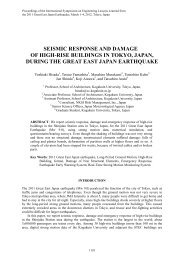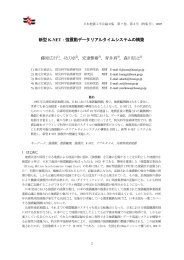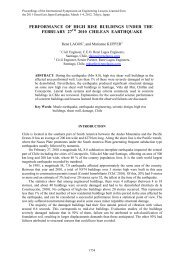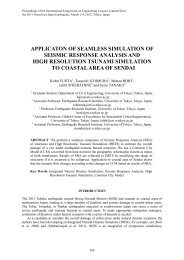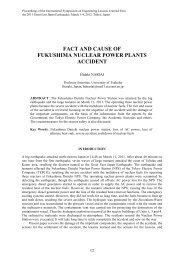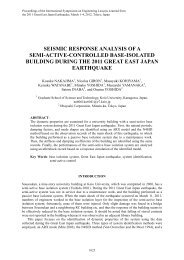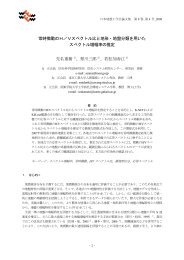typing instructions for papers of the great east japan earthquake ...
typing instructions for papers of the great east japan earthquake ...
typing instructions for papers of the great east japan earthquake ...
You also want an ePaper? Increase the reach of your titles
YUMPU automatically turns print PDFs into web optimized ePapers that Google loves.
TYPING INSTRUCTIONS FOR PAPERS OFTHE GREAT EAST JAPAN EARTHQUAKESYMPOSIUMKazuhiko KAWASHIMA 1 , Tetsuo KUBO 2 and Andrew M. GIBSON 31 Pr<strong>of</strong>essor, Department <strong>of</strong> Civil Engineering, Tokyo Institute <strong>of</strong> Technology,Tokyo, Japan, kawashima.k.ae@m.titech.ac.jp2 Pr<strong>of</strong>essor, Department <strong>of</strong> Architectural Engineering, University <strong>of</strong> Tokyo,Tokyo, Japan, kubo@arch.t.u-tokyo.ac.jp3President, Gibson & Associates, San Francisco, CA, USAgibxx@aol.comABSTRACT: Instructions <strong>for</strong> <strong>typing</strong> <strong>papers</strong> submitted to <strong>the</strong> “One Year After 2011 GreatEast Japan Earthquake - International Symposium on Engineering Lessons Learned from<strong>the</strong> Giant Earthquake-” are presented. This is an example <strong>of</strong> how to type manuscripts.The ABSTRACT shall be smaller in width than <strong>the</strong> main body by 1cm at <strong>the</strong> left and <strong>the</strong>right margins. Use Times New Roman in 11pt. The length <strong>of</strong> <strong>the</strong> ABSTRACT should notbe more than 7 lines.Key Words: Great East Japan <strong>earthquake</strong>, <strong>earthquake</strong> engineering, type instruction,<strong>for</strong>mat, Times New- Roman, 11pt, indent if key words exceed one lineINTRODUCTIONIn order to allow <strong>for</strong> a homogeneous "look" <strong>of</strong> <strong>the</strong> <strong>papers</strong>, some <strong>instructions</strong> <strong>for</strong> <strong>typing</strong> your <strong>papers</strong> arepresented here. Follow <strong>the</strong> <strong>instructions</strong> as close as possible. Papers toge<strong>the</strong>r with <strong>the</strong> cover sheetshould be submitted in electric <strong>for</strong>mat (pdf file) to eqsymp@event.jaee.gr.jp. A manuscript with sizeexceeding 8MB cannot be submitted.The maximum page <strong>of</strong> a paper is 12 pages <strong>for</strong> regular <strong>papers</strong> and 20 pages <strong>for</strong> invited <strong>papers</strong>. Apaper should have an even number.PAGE FORMAT AND MARGINS, SPACING AND TYPESUse A4 white paper sheets (21 cm x 29.7 cm). Leave 2.5 cm margins at <strong>the</strong> top and right and left sides<strong>of</strong> <strong>the</strong> text and 3.5cm margin at <strong>the</strong> bottom. Special attention has to be paid in preparing <strong>papers</strong> usingUS letter-size paper. Height and width <strong>of</strong> <strong>the</strong> main body <strong>of</strong> <strong>papers</strong> should be 23.7cm ( = 21cm - 2.5cm- 3.5cm) and 16cm ( = 21cm - 2x2.5cm), respectively, and it should be appropriately arranged so that itcon<strong>for</strong>ms to <strong>the</strong> above requirements.All main text should be single spaced, Times New-Roman types. Use 18pt in capital letters and
oldface <strong>for</strong> TITLE, 12pt <strong>for</strong> authors, and 11pt <strong>for</strong> <strong>the</strong> rest, including affiliations, abstract, main text,headings, sub-headings, sub-subheadings, acknowledgement, appendix, references, and captions <strong>for</strong>figures, photos and tables.ORGANIZATION OF THE PAPERSLeaving six lines from <strong>the</strong> top, write <strong>the</strong> TITLE <strong>of</strong> your paper, centered in 18pt capital letters andboldface types. After two line space, write your names in 12pt. Last names should be in capital.Affiliations should be cited by superscripts. Leave one line, and write affiliations, cities, countries ande-mail addresses <strong>of</strong> all authors, as indicated above. Leave two lines, and <strong>the</strong>n write abstract in 11pt.“ABSTRACT” should be in capital letters and boldface.After three lines, start main body <strong>of</strong> your paper in 11pt. The ordinary pages, starting from <strong>the</strong>second page, contain <strong>the</strong> main text from <strong>the</strong> top line. Avoid footnotes and remarks. Explain in <strong>the</strong> maintext, or in Appendices.Page should be numbered in footer, centered at bottom. Final pages are provided after <strong>the</strong> <strong>papers</strong>are accepted <strong>for</strong> publication.HEADINGSUse at most three levels <strong>of</strong> headings, i.e., headings, subheadings and sub-subheadings. Headings shallbe written in capital letters, boldface types, and centered <strong>of</strong> your text. Leave two lines space be<strong>for</strong>eheadings and one after <strong>the</strong>m. Do not indent <strong>the</strong> first line after headings, subheadings andsub-subheadings.First lines <strong>of</strong> <strong>the</strong> o<strong>the</strong>r text paragraphs should be indented as indicated here. Do not leave blanklines between paragraphs.SubheadingsSubheadings shall be written in lower-case letters and boldface types, right against <strong>the</strong> left side <strong>of</strong> yourtext, as indicated here. Leave one line space be<strong>for</strong>e and after subheadings. Use <strong>the</strong> above mentionedrules <strong>for</strong> indentation.Sub-subheadingsThe only difference with respect to subheadings is that sub-subheadings shall be in Italic and no linesspace shall be left after sub-subheadings.EQUATIONS AND SYMBOLSUse high quality fonts <strong>for</strong> both ma<strong>the</strong>matical equations and symbols. Papers with hand-writtenma<strong>the</strong>matical equations and symbols are not accepted. Equations should be centered and numbered asF ( t) aiqi( t)(1)i1G 0 sin zdz(2)in which F (t): <strong>for</strong>cing function, a i : response acceleration, and q i (t): general coordinate <strong>for</strong> i-thmode. Leave one line above and below equations. The equation number, enclosed in paren<strong>the</strong>ses, isplaced flush right. Equations should be cited in <strong>the</strong> text as Eq. (1).
FIGURES, TABLES AND PHOTOSFigures and tables shall be legible and well reproducible, and photos shall be clear. Colored figures,tables and photos are accepted. Since size <strong>of</strong> a photo taken by a new camera with high resolution isextremely large, reduce size appropriately so that size <strong>of</strong> paper does not become excessively large.Captions shall be written directly beneath figures and photos and above tables, and shall be numberedas Fig. 1, Table 1 or Photo 1. They should be written in 11pt, and centered. Long captions shall beindented. Do not use capital letter or boldface types <strong>for</strong> captions.Figures, tables and photos shall be set possibly close to <strong>the</strong> positions where <strong>the</strong>y are cited. Do notplace figures, tables and photos altoge<strong>the</strong>r at <strong>the</strong> end <strong>of</strong> manuscripts. Figures, tables and photos shouldoccupy <strong>the</strong> whole width <strong>of</strong> a page, and do not place any text besides figures, tables and photos. Leaveone line spacing above and bottom <strong>of</strong> figures, tables and photos.Do not use small characters in figures and tables. Their <strong>typing</strong> size should be at l<strong>east</strong> 9pt or larger.Table 1 Leave one line above tablesSpecimen No. Height (m) Width (m)A 2.5 4.2B 3.6 1.9C 4.8 3.2D 7.1 5.52520Counts1510500 2 4 6EventsFig. 1 Place a caption below figures leaving one line from <strong>the</strong> bottomUNITUse SI unit in <strong>the</strong> entire text, figures, and tables. If o<strong>the</strong>r units are used, provide it in paren<strong>the</strong>ses after<strong>the</strong> SI unit as 2MPa (19.6 kgf/cm 2 ).
CONCLUSIONSWrite a CONCLUSIONS section at <strong>the</strong> end <strong>of</strong> your paper, followed by ACKNOWLEDGEMENTS,APPENDICES and REFERENCES. All references should be numbered in alphabetical order. Theyare referred in <strong>the</strong> main text like (Kawashima 1995a).The reference list is followed by <strong>the</strong> dates <strong>of</strong> submission and acceptance as shown in <strong>the</strong> presentexample. The date <strong>of</strong> acceptance will be assigned after accepted <strong>for</strong> publication. They should bewritten in paren<strong>the</strong>ses in 9pt in boldface types.Acknowledgment should follow Conclusions.ACKNOWLEDGMENTSAPPENDIX DEVIATION OF EQ.(2)Appendix should be placed between Acknowledgment and References, if any.REFERENCESKawashima, K. (1995a). “Dynamic response analysis <strong>of</strong> structures.” Journal <strong>of</strong> EarthquakeEngineering, Vol. 3, No. 2, 213-222.Kawashima, K. (1995b). “Seismic damage in <strong>the</strong> past <strong>earthquake</strong>s.” Journal <strong>of</strong> EarthquakeEngineering, Vol. 7, No. 3, 151-159.Priesley, M. J. N., Seible, F. and Calvi, G. M. (1996). “Seismic design and retr<strong>of</strong>it <strong>of</strong> bridges.” WileyInterscience Publications, New York, USA.Vesic, A. (1961). “Beams on elastic foundation.” Proc. 5th International Conference on SoilMechanics and Foundation Engineering, Vol. 1, 845-850.




